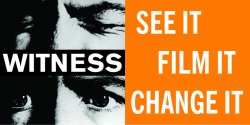TACTIC 2: PLAN YOUR ACTION
SOMEONE IS WATCHING
witness and record
download this tactic card (pdf 1mb)

ANTONY TURBA (FLICKR)
Plan your action
- In Burma, bloggers and rights advocates faced significant risks in coming forward with their testimonies and evidence. How will you protect yourself and others involved in and supporting your campaign? Consider the digital trail you may leave: your IP address, email accounts, passwords, lists of friends you have on social network sites, the names that your mobile phones and SIM cards were purchased under, and the names and organisations that websites’ domain names have been registered to.
- Develop criteria for verifying the witness reports you collect and publish. Some citizen reporting platforms have been abused to accuse innocent people and expose dissidents’ identities.
- One way that WITNESS has protected the identities of people in video testimony is to not record their faces. By backlighting a person, you can record a silhouette of his or her face without showing revealing details. In this way, even if your tapes were seized, there would be no visual record of the people in them.
- Talk people through the “worst case scenario” if they told their story and their identity was compromised or revealed. This discussion allows you to get informed consent from people and can help you plan how to minimise risk.
Do it yourselfAsk
- Are you going to have time to plan how to collect witness testimonies? Or are you preparing advocates and supporters to spontaneously collect material in the most ethical and strategic way?
- What tools do people most impacted by your issues already have available to them to document rights abuses – mobile phones, digital cameras, access to social network sites and blogging?
- How can you respect the integrity of the people whose stories your campaign is sharing with a much broader audience?
- What is your media and outreach strategy? How will you respond to the press rapidly should your materials become part of a breaking news story?
- Who are you in relationship to the issue or community you are working with?
- How will you respond to requests for you to take down materials from your or others’ websites, either from governments, commercial web services, or people impacted by the images, videos, and blog posts?
Different ways you can do this
- You don’t need to use video. Ask people to use their mobile phones to send photos by email or if possible by multimedia message (MMS), which can later be made into a slideshow or published on their own.
- If it’s not possible to conceal people’s identities visually, you can use animation, puppetry, or photo montage as a way of digital storytelling.
- Being able to witness events fi rst-hand is rarely possible. You can reconstruct some events later through interviews, and by being introduced to people involved through trusted allies and contacts.
- Rather than recording the faces of people at live events, consider alternative, safer ways to get footage that will tell the story of an action or protest.
- For video intended to bring corruption to light, think about how you can explain clearly the roles of the people in it and their relationships to each other. By visually mapping these relationships you can highlight links between people, organisations, and corruption.
|
FEATURED TOOL A trusted video sharing community for human rights advocates |
TIPS VIOLETA KRASNIC, FROM WITNESS, ON CONCEALING IDENTITY: "Filming concealed identity interviews is a matter of trust, in people and in technology. Our consent process conveys the purpose of the video and its intended use in the video advocacy campaign and is built on an understanding of the security implications of the interview."
AUNG, BURMESE RIGHTS ADVOCATE, ON GETTING INFORMATION OUT: "The Saffron Revolution clearly indicated how citizen journalists are powerful for our country. Sometimes we bring information across the border using recording devices, and sometimes we use email or FTP – these are the sorts of methods we are using so far. Even though the regime has tried to shut down everything, bloggers and citizen journalists have been able to bring information to the outside media."
PRISCILLA NERI, FROM WITNESS, ON ETHICS AND PUBLICATION: "With so many questions unanswered in the video of Neda, I find myself without a good solution [for] what to do with it. What I know for sure is that it must be seen, and the young woman’s dignity must be respected. Perhaps this delicate balance can be achieved by blurring her identity in the video, or by thinking twice before selecting the image of her bloodied face as your new Facebook status." |
